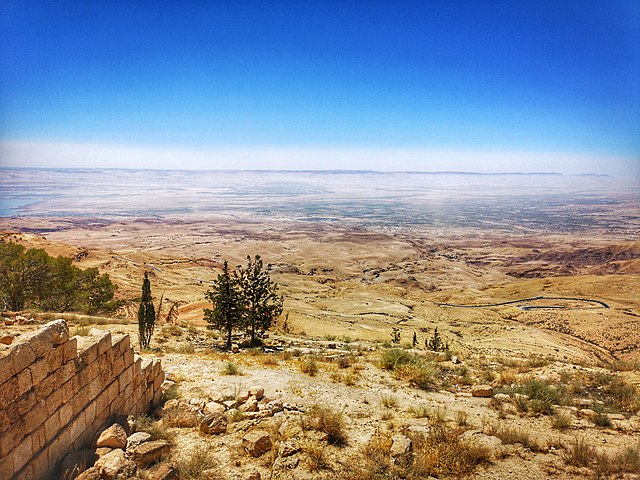毎年、ほぼ毎日といえる考古学的な発見は、聖書のより良い理解と、聖書の人物や出来事、文化の詳細を確認するのに役立っている。以下は、2018年に報じられた、聖書の世界と初期キリスト教史の知識を深めることになった発掘調査結果のトップ10だ。
[toggle]Each year, on an almost daily basis, archaeological discoveries help us better understand the Bible and affirm its details about people, events, and culture.Below are the top excavation findings reported in 2018 which have increased our knowledge of the biblical world and the early history of Christianity. [/toggle]

モーセが眺めた約束の地(写真:John Romano D’Orazio)
2018年初頭、エルサレムの西端にある古代の陶器職人の村の調査で、文字の刻まれた石柱が発見された。そこには、エルサレムのヘブライ語綴(つづ)りである「イェルシャライム」という単語も刻まれていた。紀元前100年のものとされる。
[toggle]Archeologists uncovered an inscription on a pillar in an excavation of an ancient potter’s village, near the western edge of the modern city of Jerusalem earlier this year. The inscription includes the word, “Yerushalayim,” the name of Jerusalem written in Hebrew, and was dated to 100 B.C. [/toggle]当時、この陶器職人の村で、数キロ東にあるエルサレムに巡礼に来た人々の世話をしていたことは間違いない。ユダの金で祭司長たちが買った「陶器職人の畑」(マタイ27:7)を思い起こさせる地だ。
[toggle]The potter’s village no doubt served the many pilgrims who were on their way to the Temple in Jerusalem, just a few miles to the east. It calls to mind the potter’s field in Matthew 27:7 that was bought by the priests with the money Judas took for betraying Jesus and then returned. [/toggle] [toggle]9) Clay pomegranate found at Tel Shiloh[/toggle]イスラエルによるカナン征服とエルサレム神殿時代の間、幕屋と契約の箱が置かれていたシロ(ヨシュア18:1)で、2018年、ざくろの形の土器が発見された。聖書でざくろは、神殿の装飾(列王上7:18、列王下25:17)や祭司の上着の裾(すそ)飾り(出エジプト28:33)に用いられる。
[toggle]Tel Shiloh, the site where the Jewish tabernacle and the Holy Ark were located between the Israelite conquest and the building of the Temple in Jerusalem, yielded an unusual clay pomegranate in an excavation this year. In the Bible the pomegranate is a common temple decoration (1 Kings 7:18; 2 Kings 25:17), and small pomegranate decorations hung from hems of the robes of the priests (Ex. 28:33). [/toggle] [toggle]8) Esarhaddon inscriptions found at the shrine of Jonah[/toggle]IS(過激派「イスラム国」)は2014年、イラクのモスルにある預言者ヨナの墓を破壊した。今は廃墟となったこのイスラム寺院は丘の上にあり、そこでアッシリア帝国のエサル・ハドン王の宮殿の遺跡を考古学者が発見したのだ。エサル・ハドン王の名が刻まれた碑文はトンネルの中から発見されたが、それはISが骨董市場に遺物を売るため掘られたものだった。考古学者らは今も、神殿の遺跡を調査するため、これらのトンネルを使っている。
[toggle]In 2014 ISIS blew up the shrine of the tomb of the prophet Jonah in the Iraqi city of Mosul. The now-destroyed Muslim shrine had been situated on a mound, where archaeologists soon found the remains of a palace of the Assyrian King Esarhaddon. The king’s name is referenced in inscriptions discovered in tunnels ISIS dug into the mound, as the group searched for artifacts to sell on the antiquities market. Today, archaeologists are using these tunnels to investigate the temple remains. [/toggle]聖書でエサル・ハドンについては、ヒゼキヤ王の時代、ユダ王国の多くを破壊したもののエルサレムは陥落できなかった父センナケリブ(列王下18:13)が暗殺された際に言及されている(同19:36~37、イザヤ37:37~38)。エサル・ハドンは紀元前681~669年、王位にあった。預言者ヨナはそれより1世紀以上前の人物で、実際にはその墓地も分かっていないため、今回の考古学的発見はむしろアッシリア帝国末期について多くの情報を提供してくれるだろう。
[toggle]The Old Testament references Esarhaddon when discussing the assassination of his father Sennacherib (1 Kings 19:36–37; Isa. 37:37–38), who was the king who ravaged much of Hezekiah’s kingdom of Judah and unsuccessfully besieged Jerusalem. Esarhaddon himself reigned from 681–669 B.C. Information archaeologists discover in the remains of his palace will tell us more about the latter days of the kingdom of Assyria than of the time of Jonah, who lived almost a century earlier and whose actual final resting place is unknown. [/toggle] [toggle]7) Semitic abecedary found in Egypt[/toggle]聖書の歴史は、文字を書く歴史と何度も交差する。1995年、エジプトのルクソール、ナイル川西岸の墓で発見された石灰岩に刻まれた文字を、ブリティッシュコロンビア大学のエジプト学者トーマス・シュナイダー教授が解読し、2018年、それがとても古い時代のセム語で、ABC順のアルファベットであることを発表した。
[toggle]Biblical history intersects multiple times with the history of writing, as illustrated by an inscribed piece of limestone discovered in 1995 in a tomb along the west bank of the Nile at Luxor. University of British Columbia Egyptologist Thomas Schneider has deciphered the letters and announced this year that it’s an abecedary, a very early version of the Semitic alphabet in ABC order. [/toggle]探索された墓は紀元前1450年代に遡(さかのぼ)るもので、聖書年代学的にはモーセの時代に当たる。モーセが「主の言葉をすべて書き記し」ていたとしたら(出エジプト24:4)、モーセはただ一人、エジプトにおいてセム語を書ける人物ではなかったことになる。
[toggle]The excavated tomb dates back to 1450 B.C., the time of Moses, according to the biblical chronology. It suggests that if “Moses wrote down everything the Lord had said” (Ex. 24:4), he wasn’t the only one writing in a Semitic script in Egypt at that time. [/toggle]6位 メギドの王家の墓
[toggle]6) Unlooted royal family tomb at Megiddo[/toggle]2016年にイスラエルのメギド(ヨシュア17:11など)の丘で発掘されたカナン人の墓について、18年前半、新情報が発表された。3月の最初の発表では、3700年前の墓が手つかずのまま、略奪もされていないことに考古学者たちは驚いていた。遺体は、男性も女性も子どもも、金や銀の宝石で飾られていたのだ。
[toggle]A Canaanite tomb excavated at Tel Megiddo in 2016 and announced earlier this year has revealed new information about the inhabitants of one of the most famous and important ancient cities in the region. At the original announcement last March, archaeologists marveled that the 3,700-year-old tomb was still intact and unlooted, yielding the remains of a man, a woman, and a child, all adorned with gold and silver jewelry. [/toggle]墓からは、族長時代にあたるカナン文化についての新たな発見が期待された。そして最近になって、墓から発見された水差しに付着した残滓(ざんし)がバニラであることが分かり、報告された。バニラは当時、この地では知られておらず、使用もされていなかった。この発見は、香料の取引が当時行われていたことを示している。(後編に続く)
[toggle]From the tomb, archaeologists expected to learn much more about the Canaanite culture that existed in Israel during the time of the patriarchs. And, indeed, just a few weeks ago it was reported that residue in one of the jugs from the tomb was discovered to be vanilla, which was not thought to have been known nor used in that part of the ancient world at that time. The finding illustrates the robust spice trade of the ancient world. [/toggle]